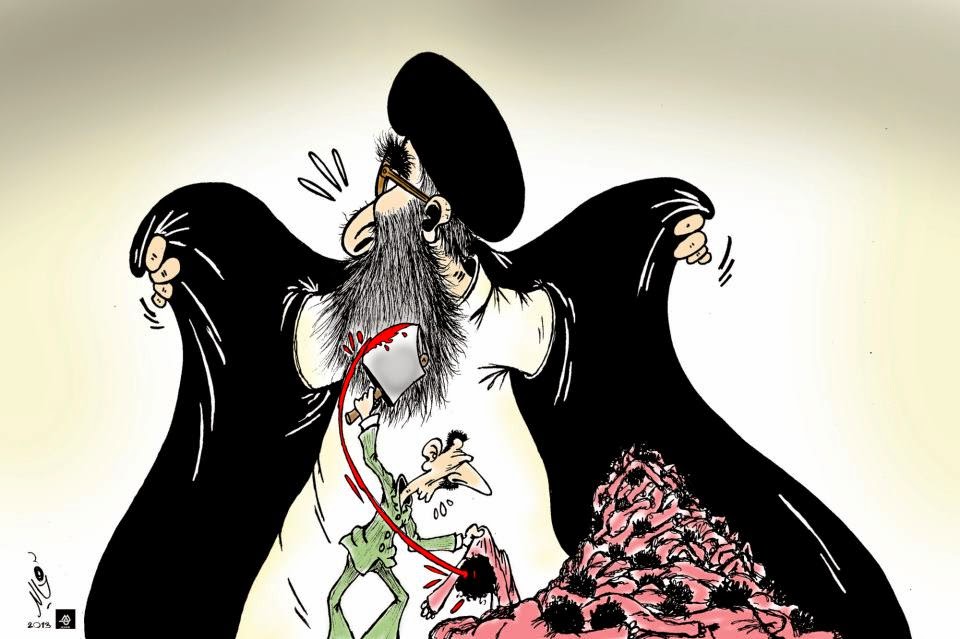Peter Klæstrup
Pages for a new History of Political Cartooning in Denmark
 |
| Peter Klæstrup for Corsaren, No. 50, 1841: "The Opposition Press and the People". This is the very first cartoon of "Mr. People", (Hr. Folket) later named "Mr. Sørensen" (Hr. Sørensen). |
Peter Klæstrup (1820-1882) was the cartoonist of the satirical weeklies Corsaren, Folkets Nisse and Pjerrot, of which he first drew for Corsaren in 1841. Klæstrup was in other words the first cartoonist in Denmark.
Art history has a tendency to focus on the artists, who happened to do a few funny sketches on the side of stupid contemporaries. Artists of the common mold have careers more easily defined as a whole and it is so much easier to write about them. Klæstrup was consequently next to written out of history
He does not suit coffee-table art books. He is sharp, he is different and he has found two great admirers in us. Klæstrup graduated from the Royal Academy, but the very same year, being only 21 years old, he began working for the new critical weekly Corsaren.
 |
| Peter Klæstrup for Folkets Nisse, No. 88, November 13, 1852. The nose and the heavy eyelid is pure inspiration from Daumier in Le Charivari. |
Klæstrup had a knack for transforming critical ideas to the tiny format - most of his drawings were lithographed and then printed to just 3 cm. in height. Much of his detailing was lost in the lithographic adaptation and yet the printed outcome is sharp in wit as they are sharp in their black outline.
Their meaning is detected on the spot, they jump from the page, usually literally, such as the two ballet girls, whose zig zaggy-lines make them seem to be continuously leaping in front of us. Repeated razor lines on the lower legs create for a jagged rhythm to which is added their doll-like slackness: They are the antimony of ballet and its ideals of long lines and heads held high with arms and legs reaching beyond the human form. On its own a drawing mocking those very ideals, but it was placed on a spread of drawings on the 1864-war against Germany with the Danish troops abandoning all tactics and fleeing the battlefield.
 |
| Peter Klæstrup for Folkets Nisse, No. 7, February 13, 1864. |
The ballet girls were printed in Folkets Nisse, which was openly critical of both wars in the time of its existence, mocking all elements within the lack of necessity of it. Klæstrup put it all into imagery.
 |
| Peter Klæstrup for Corsaren, 1841. - Dammit, I have no time for you today, mister, you must come back another time. |
Among his very first creations was the character of the quintessential Dane, Mr. People (Hr. Folket, later Hr. Sørensen), who reflected the impact of international and domestic politics. He was the one to insist the king, Christian VIII pay his debts to his people in 1841. Mr. People underwent a number of transformations. Here he is made all the leaner to make room for the vanity of autocracy.
The King was not mentioned by name, but his portrait unmistakable and the defamation all the greater. The actual features of the person portrayed was to be the line of Danish cartoon art.
The King was not mentioned by name, but his portrait unmistakable and the defamation all the greater. The actual features of the person portrayed was to be the line of Danish cartoon art.
 |
| Munch and Klæstrup. Photo by Louise. |
We see Klæstrup today through eyes that are familiar with the woodblock experiments of Munch, Toulouse-Lautrec and Käthe Kollwitz.
They were not even born when the cartoons shown were made. Munch was born in 1863, Toulouse-Lautrec in 1864 and Kollwitz in 1867 and the art of Hokusai would not even be known in Europe for another 10 years.
They were not even born when the cartoons shown were made. Munch was born in 1863, Toulouse-Lautrec in 1864 and Kollwitz in 1867 and the art of Hokusai would not even be known in Europe for another 10 years.


